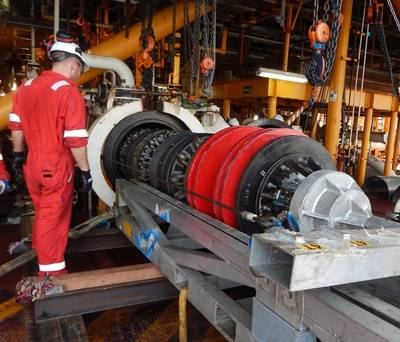Gas Flows To Millions in Thailand While Pipeline Repaired
Responsible for providing Thailand with 20 percent of its annual natural gas supply, PTT Exploration and Production Public Company Limited (PTTEP) works hard to make certain that natural gas production from the Bongkot and Erawan Production Platforms, located in the Gulf of Thailand, flow with little disruption. PTTEP is vigilant for safety and efficiency, continually inspecting its pipeline network to ensure that repairs are made in a timely manner. PTTEP’s challenge is to repair its lines quickly and safely, with minimal disruption to production.
Since replacing valves is a routine function in pipeline maintenance, the PTTEP team responded rapidly when it identified three topside valves in need of replacement on the gas export riser attached to the Bongkot platform. The Bongkot platform is connected to a major export line that extends to the Erawan production platform, a primary hub of gas production in Thailand, through which millions of cubic feet of natural gas are transported daily to the onshore processing plant in Rayong, Thailand.
To ensure efficient replacement of the valves, PTTEP partnered with global pipeline service provider T.D. Williamson (TDW) to isolate pressure in the pipeline from the work zone and depressurize the affected section. By doing so, a safe working environment would be created in which the pipeline repair contractor could replace the defective valves. PTTEP had opted for the isolation method to prepare for repair work so as to avoid the downtime, expense and disruption of bleeding the entire line. The objective was to keep interruption to gas production to a minimum: no more than 10 days.
Following months of pre-engineering work and preparation carried out in close cooperation with the PTTEP project team, the TDW team deployed a triple module 32-inch SmartPlug® pressure isolation tool. The triple module configuration features two modules for isolating the pipeline inventory during the valve replacement works, and a third plug module to act as barrier for post-repair hydrostatic testing.
The system would be used to achieve a double-block isolation against gas pressure in the pipeline. The SmartPlug system is characterized as double-block because the two plug modules act independently from one another, thereby satisfying the requirement for double isolation, as required by Det Norske Veritas (DNV) and other regulatory bodies.
10-day pressure isolation = safe work zone
Working from the Bongkot platform, TDW launched the SmartPlug tool into the line, pigging it in potable water for approximately 40 meters past the hanger flange and into the vertical set location in the riser. As it traveled through the line, TDW tracked the tool’s progress with its remotely operated SmartTrack™tracking and monitoring system, which uses extremely low frequency (ELF) signals. The system also monitors pressure between the two plug modules to ensure that it remains at a safe operating level throughout the isolation operation. Tracking and monitoring are achieved by the system’s two-way, through-wall, electromagnetic communication capability between an external transponder and the receiver in the tool. Upon setting the isolation tool at the pre-determined destination, it was sealed against a safe operating pressure of approximately 100 bar (1450 psi) for 10 days.
Secure in the knowledge that the line was safely isolated, the two valves were replaced during the isolation period. Following replacement of the valves, TDW carried out a hydrotest to a pressure of 132 bar (1930 psi) against the tool’s third plug module to verify the integrity of the repair work. With the hydrotest successfully completed and integrity of the repair work verified, PTTEP was satisfied that the valves had been repaired, signalling the successful completion of the operation. The pressure over the SmartPlug tool was then equalized, the plug modules unset, and the tool pigged back to the launcher using the gas pressure from the pipeline. Finally, the pressure was bled at the launcher side.
“When we completed the 32-inch Bongkot Valve Replacement and Riser Wrapping project in late April 2014, gas export had already resumed,” said a Division Manager for PTT. ”This could not have happened without the dedication and great cooperation among all parties. On behalf of PTT, I would like to thank everyone directly and indirectly involved in the 32-inch Bongkot project, including Bongkot JV, PTTEP project team, PTTEP platform team, PTT and PTTEP contractors, who gave full assistance and commitment to help a support the project so that it could be completed safely and effectively. Your kindness will always be remembered,” he added.
By employing the pipeline pressure isolation method for the Bongkot - Erawan pipeline repair program, PTTEP realized a number of benefits. “This field-proven technology allows maintenance to be carried out without blowing down or depressurizing the pipeline, each of which is a very complex, time-consuming and expensive process,” said Rolf Gunnar Lie, Regional Business Development Manager - Far East Asia Pacific for TDW. “The fact that the downstream sections of the repair zone can be isolated, with just the repair zone depressurized, is extremely important because repair work can be completed safely, with minimal disruption to production.












